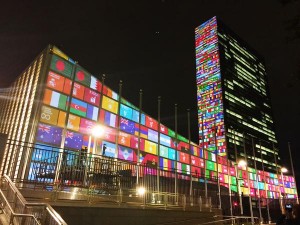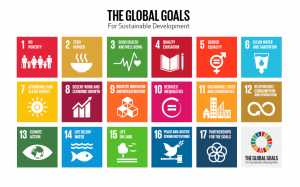Setting goals to end poverty, inequality and climate change
Professor Asghar Zaidi explains the UN’s new Sustainable Development Goals: what they are and why they matter.
In September 2015, at one of the largest summits at the United Nations Headquarters in New York, Heads of State and High Government Representatives signed a commitment document for new global goals that aim to bring peace and prosperity all over the world and reduce climate change and its impact.
The post-2015 Sustainable Development Goals (SDGs) contain goals and targets covering a broad range of issues relating to people as well as our planet. This builds on a proposal first raised at the Rio+20 Summit in 2012, and the subsequent three-year process involved wide consultations with national policy officials, civil society organisations and surveys engaging more than seven million people.
UN Member States finally agreed on a list of 17 goals, further disaggregating them into 169 targets. Although these goals are not legally binding, they now have the potential to become an important agenda towards future international development in countries around the world.
The SDGs come into effect at the end of 2015 – following the completion of the Millennium Development Goals (MDGs) – and cover 2016-2030. Unlike the MDGs, which were aimed largely at poorer countries, the SDGs are designed to be universal, involving the entire world, developed and developing countries alike, and covering all people of all ages.
It is therefore not surprising which countries are predicted to meet the goals first. Sweden, according to one report, will be the first, and Norway, Denmark, Finland and Switzerland are close behind.
Not everyone agrees with the goals, however. A piece in The Lancet described them as “fairy tales, dressed in the bureaucratese of intergovernmental narcissism, adorned with the robes of multilateral paralysis, and poisoned by the acid of nation-state failure”.
The 17 SDGs aim to eradicate hunger and poverty, while at the same time promoting peace, prosperity, health and education and combating climate change. Achieving these goals will see a partnership between national governments, civil society organisations, and worldwide business communities.
Leaving no one behind and reaching the furthest behind first
You will wonder about what these pledges are and how effective they will be? The essence of the pledges are in two formulations: ‘no one will be left behind’ and ‘to reach the furthest behind first’. They imply that every individual will receive the fullest benefits of rights and opportunities the SDGs offer, and those most vulnerable will get the highest priority in the human development agenda.
These commitments could not come at a more opportune time. Billions of people around the world continue to live in poverty, in societies where inequalities are rising, within and across countries. Eradicating unemployment – particularly youth unemployment – is a major challenge. Population ageing presents a major concern for countries around the world, rich and poor.
Global health threats, natural disasters, conflict and violence, have particular impact on people already at the margins and most vulnerable, such as children, persons with disabilities, and older frail persons. The idea that ‘no goal should be met unless it is met for everyone’ is well established in the formulation of the SDGs.
Monitoring framework of indicators
The SDGs and their targets will be followed up and reviewed systematically using a set of global, largely quantitative, indicators. The global indicator framework will be developed by the specially convened Inter-Agency Expert Group on SDG Indicators, to be agreed subsequently by the UN Statistical Commission and adopted thereafter by the Economic and Social Council and the General Assembly by September 2016, exactly a year after the signing of the goals.
Additional indicators at the regional and national levels, to be developed by national authorities, will complement these global indicators. Most importantly, the statistical work required at the outset will include specific information on the baselines for those targets and for many countries the baseline data does not yet exist.
The development of this indicator framework will be challenging as it must address all SDGs and all aspects included in the targets as well as be pragmatic about the means of implementation by national statistical authorities. The pledge to leave no-one behind would imply the need for expanded data and information on different social groups, and in many countries the existing statistics are currently not suitable for this purpose.
How we moved on from the Millenium Development Goals?
The SDGs follow the tradition of the MDGs which arose as a product of the consensus built in the United Nations-led conferences and summits during the 1990s. However, when it came to crystallising the goals to set the agenda for post-millennium development, the choices of issues considered in the MDGs were narrow and selective, including only “safe” issues, whereas other more complex issues related to governance, human rights, inequality, ageing, peace and climate change were left out.
In contrast, the SDGs process capitalised on the energy and input of stakeholders worldwide. In this context, 100 national dialogues were organised covering all regions of the world, many included social groups such as older persons and persons with disabilities. In addition, 11 on-line thematic consultations took place. As a result, a large number of constituencies made significant progress in gaining recognition and making their voices heard in the development of the SDGs.
What relevance for older people?
In contrast to the MDGs, there is specific mention of older persons in five Goals. While the principal of participation has been embedded in the discussions leading to SDGs, the challenge remains to ensure that the implementation phase continues to include multi-stakeholder participation.
There are references to older persons, age, “for all”, “all” and “lifelong” in 12 of the 17 goals. Also, in a number of targets, there is a broader commitment that ‘all indicators should be disaggregated by sex, age, residence (urban/rural) and other characteristics, as relevant and possible. There is a need still that specific age groups should be defined with clear and appropriate distinctions within the group of older persons, not reduced to single subgroups such as 50+ or 60+ only.
Goal 3, Ensure healthy lives and promote well-being for all at all ages, is particularly relevant for older people pointing to empowering older people to not just benefit from the development process but also be net contributor towards all future international development processes.
From the indicators proposed so far, a large number already capture the needs and resources of older people. That said, some indicators still require additional breakdown by age. Additional indicators are: the number of older persons affected by poverty; hazardous events; HIV prevalence rate among older persons; mortality among older persons aged 70+ from NCDs; substance abuse by older age groups; access to education and training for older persons; violence against older persons, especially older women; financial inclusion of older persons; treatment of older migrant persons as well as physical safety of older persons in their local neighbourhood.
The 35-page United Nations text outlining the post-2015 development agenda is available here.
Professor Asghar Zaidi is a Professor in International Social Policy at the University of Southampton. His other positions include Visiting Professor at London School of Economics, and Senior Advisor at the European Centre, Vienna.




Leave a Reply
You must be logged in to post a comment.